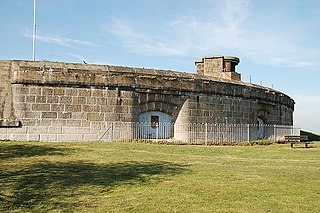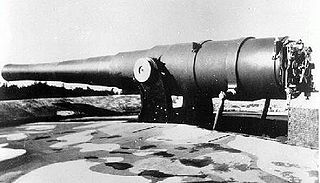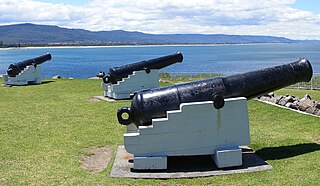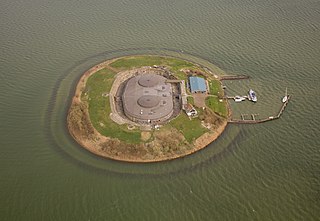
Coalhouse Fort is an artillery fort in the eastern English county of Essex. It was built in the 1860s to guard the lower Thames from seaborne attack. It stands at Coalhouse Point on the north bank of the river, at a location near East Tilbury which was vulnerable to raiders and invaders. It was the last in a series of fortifications dating back to the 15th century and was the direct successor to a smaller mid-19th century fort built on the same site. Constructed during a period of tension with France, its location on marshy ground caused problems from the start and led to a lengthy construction process. The fort was equipped with a variety of large-calibre artillery guns and the most modern defensive facilities of the time, including shell-proof casemates protected by granite facing and cast-iron shields. Its lengthy construction and the rapid pace of artillery development at the time meant that it was practically obsolete for its original purpose within a few years of its completion.

Beacon Hill Battery is a late-19th and 20th century coastal fortification that was built to defend the port of Harwich, Essex. It is a scheduled ancient monument.

Wrights Hill Fortress is a counter bombardment coastal artillery battery in the Karori suburb of Wellington, New Zealand. It was built between 1942 and 1944 and is predominantly underground, with numerous tunnels linking the war shelters, gun emplacements, magazines, plotting rooms and engine room – which are, at some points, over 50 feet underground. The fort was intended to house three 9.2" Mk. XV guns, but only two guns were installed and the fort never saw action. After World War II was over, fort commanders fired both of the guns. The fall of the shot was observed in Cook Strait and these test firings were deemed a success. In 1960, somewhat ironically, both of the guns were sold to the Japanese as scrap metal, the very nation Wrights Hill Fortress was constructed to defend Wellington against. The design of the fort is similar to the Stony Batter and Whangaparāoa 9.2" Mk. XV batteries, near Auckland.

York Redoubt is a redoubt situated on a bluff overlooking the entrance to Halifax Harbour at Ferguson's Cove, Nova Scotia, Canada, originally constructed in 1793. It was designated a National Historic Site of Canada in 1962.

Fort Rodd Hill National Historic Site is a 19th-century coastal artillery fort on the Colwood side of Esquimalt Harbour,. The site is adjacent to Fisgard Lighthouse National Historic Site, the first lighthouse on the west coast of Canada. Both the fort and lighthouse are managed and presented to the public by Parks Canada.

The Ben Buckler Gun Battery is a heritage-listed fortified former gun emplacement and military installation of the late-Victorian period and now public open space located in the North Bondi locality of Ben Buckler, in the Sydney, Australia. The gun battery was designed by NSW Colonial Government and built during 1893. It is also known as Ben Buckler Gun Battery 1893, 9.2 Disappearing Gun and Bondi Battery. The property is owned by Waverley Municipal Council. It was added to the New South Wales State Heritage Register on 15 December 2006.

Malabar Battery was a coastal defence battery built in 1943 during World War II at Malabar Headland in Sydney, Australia. The battery is also known as Boora Point Battery.

The Steele Point Battery is a small fort, on the shores of Port Jackson in the eastern Sydney suburb of Vaucluse, Australia.

Flagstaff Hill Fort is a former military fort at Flagstaff Point, Wollongong, New South Wales, Australia.

Drummond Battery, also known as Fort Drummond, is a heritage-listed former coastal artillery fortification and now television station and mushroom farm at 1 Television Avenue, Mt Drummond, Mount Saint Thomas, City of Wollongong, New South Wales, Australia. It was built between 1942 and 1943 by the NSW Public Works Department and NSW Department of Main Roads. The Australian Army used the site from 1942.

Pampus is an artificial island and late 19th-century sea fort located in the IJmeer near Amsterdam. Pampus now belongs to the municipality of Gooise Meren and is open to visitors.

Culver Battery is a former coastal artillery battery on Culver Down, on the eastern side of the Isle of Wight, England. The fortification is one of several Palmerston Forts built on the island following concerns about the size and strength of the French Navy in the late 19th century. It was operational during the First and Second World Wars. The battery was closed in 1956.

Fort Cowan Cowan is a heritage-listed World War II fortification at 30 Jessie Wadsworth Street, Moreton Island, City of Brisbane, Queensland, Australia. It is also known as RAN 3 Cowan Cowan, Fort Cowan and Cowan Cowan Battery. It was added to the Queensland Heritage Register on 1 October 2007.

Fort Campbell, also known locally as Il-Fortizza ta' Selmun, is a former fort in Mellieħa, Malta. It was built by the British during 1937 and 1938. It is notable as the most important fortification north of the Victoria Lines, and the last major fortification to be built in Malta. Today, it lies in ruins.

Fort Davis, is a coastal defence fortification close to Whitegate, County Cork, Ireland. Together with similar structures at Fort Mitchel, Fort Camden (Crosshaven), and Templebreedy Battery, the fort was built to defend the mouth of Cork Harbour. Though used as a fortification from the early 17th century, the current structures of the 74-acre site date primarily from the 1860s. Originally named Fort Carlisle and operated by the British Armed Forces, the fort was handed-over to the Irish Defence Forces in 1938, and renamed Fort Davis. The facility is owned by the Department of Defence, and is used as a military training site with no public access.

The Bribie Island Second World War Fortifications are heritage-listed fortifications at Woorim and Bribie Island North on Bribie Island, Queensland, Australia. They were built from 1939 to 1943 and were added to the Queensland Heritage Register on 20 July 1993.

False Cape Battery is a heritage-listed fortification at Yarrabah Road, East Trinity, Cairns Region, Queensland, Australia. It was built from 1942 to 1943 during World War II. It is also known as Leper Bay. It was added to the Queensland Heritage Register on 18 April 1997.

Kissing Point Fortification is a heritage-listed fortification at 38-40 Howitt Street, North Ward, City of Townsville, Queensland, Australia. It was designed by Peter Scratchley and Major Edward Druitt and built from 1891 by A McMillan and then from 1939 to 1941. It is also known as Jezzine Barracks. It was added to the Queensland Heritage Register on 5 February 2010.

The Shepherds Hill military installations is a New South Wales state heritage-listed site, consisting of a former military gun battery emplacement, observation post and gunner's cottage at The Terrace in Newcastle, New South Wales, Australia. It was built from 1890 to 1940. It is also known as Shepherds Hill Defence Group Military Installations, Observation Post and Gun Placement and Shepherds Hill Battery. It was added to the New South Wales State Heritage Register on 2 July 2010.

Green Hill Fort is a heritage-listed fortification at Chester Street, Thursday Island in the Torres Strait, Queensland, Australia. The fort is important in Australian military history as a strategic coastal defence installation in the period of transition from British to Australian responsibility for defence. The 1885 confrontation between Britain and Russia, which almost resulted in open conflict, galvanised the Australian colonies to jointly fund construction of the fortifications, and these represent an important and uncommon instance of pre-Federation Colonial cooperation on defence in the "national" interest. The fort was added to the Australian Commonwealth Heritage List on 28 May 2008.


















